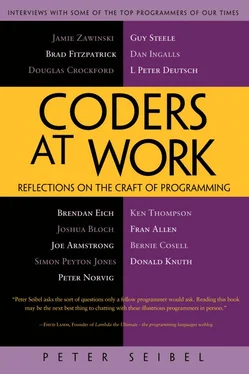Peter Seibel - Coders at Work - Reflections on the craft of programming
Здесь есть возможность читать онлайн «Peter Seibel - Coders at Work - Reflections on the craft of programming» весь текст электронной книги совершенно бесплатно (целиком полную версию без сокращений). В некоторых случаях можно слушать аудио, скачать через торрент в формате fb2 и присутствует краткое содержание. Жанр: Программирование, на английском языке. Описание произведения, (предисловие) а так же отзывы посетителей доступны на портале библиотеки ЛибКат.
- Название:Coders at Work: Reflections on the craft of programming
- Автор:
- Жанр:
- Год:неизвестен
- ISBN:нет данных
- Рейтинг книги:3 / 5. Голосов: 1
-
Избранное:Добавить в избранное
- Отзывы:
-
Ваша оценка:
- 60
- 1
- 2
- 3
- 4
- 5
Coders at Work: Reflections on the craft of programming: краткое содержание, описание и аннотация
Предлагаем к чтению аннотацию, описание, краткое содержание или предисловие (зависит от того, что написал сам автор книги «Coders at Work: Reflections on the craft of programming»). Если вы не нашли необходимую информацию о книге — напишите в комментариях, мы постараемся отыскать её.
Coders at Work
Founders at Work
Coders at Work: Reflections on the craft of programming — читать онлайн бесплатно полную книгу (весь текст) целиком
Ниже представлен текст книги, разбитый по страницам. Система сохранения места последней прочитанной страницы, позволяет с удобством читать онлайн бесплатно книгу «Coders at Work: Reflections on the craft of programming», без необходимости каждый раз заново искать на чём Вы остановились. Поставьте закладку, и сможете в любой момент перейти на страницу, на которой закончили чтение.
Интервал:
Закладка:
This one you couldn’t attack. It wasn’t until I wrote this intensive multiply/divide program that it saw the frequency of the error went way, way up. Instead of crashing once every couple of days you’d crash once every couple of minutes. And then as soon as you got something that would crash the machine you had a fighting chance to find it.
Seibel:So some folks today would say, “Well, certainly assembly has all these opportunities to really corrupt memory through software bugs, but C is also more prone to that than some other languages.” You can get pointers off into la-la land and you can walk past the ends of arrays. You don’t find that at all problematic?
Thompson:No, you get around that with idioms in the language. Some people write fragile code and some people write very structurally sound code, and this is a condition of people. I think in almost any language you can write fragile code. My definition of fragile code is, suppose you want to add a feature—good code, there’s one place where you add that feature and it fits; fragile code, you’ve got to touch ten places.
Seibel:So when there’s a security breach that turns out to be due to a buffer overflow, what do you say to the criticism that C and C++ are partly responsible—that if people would use a language that checked array bounds or had garbage collection, they’d avoid a lot of these kinds of problems?
Thompson:Bugs are bugs. You write code with bugs because you do. If it’s a safe language in the sense of run-time-safe, the operating system crashes instead of doing a buffer overflow in a way that’s exploitable. The ping of death was the IP stack in the operating system. It seems to me that there’d be more pings of death. There wouldn’t be pings of “take over the machine becoming superuser.” There’d be pings of death.
Seibel:But there is a difference between a denial-of-service attack and an exploit where you get root and can then do whatever you want with the box.
Thompson:But there are two ways to get root—one is to overflow a buffer and the other is to talk the program into doing something it shouldn’t do. And most of them are the latter, not overflowing a buffer. You can become root without overflowing any buffers. So your argument’s just not on. All you’ve got to do is talk su into giving you a shell—the paths are all there without any run-time errors.
Seibel:OK. Leaving aside whether it results in a crash or an exploit or whatever else—there is a class of bugs that happen in C, and C++ for the same reason, that wouldn’t happen in, say, Java. So for certain kinds of applications, is the advantage that you get from allowing that class of bugs really worth the pain that it causes?
Thompson:I think that class is actually a minority of the problems. Certainly every time I’ve written one of these non-compare subroutine calls, strcpyand stuff like that, I know that I’m writing a bug. And I somehow take the economic decision of whether the bug is worth the extra arguments. Usually now I routinely write it out. But there’s a semantic problem that if you truncate a string and you use the truncated string are you getting into another problem. The bug is still there—it just hasn’t overflown the buffer.
Seibel:When you’re debugging, what tools do you use?
Thompson:Mostly I just print values. When I’m developing a program I do a tremendous amount of printing. And by the time I take out, or comment out, the prints it really is pretty solid. I rarely have to go back.
Seibel:And what kinds of things do you print out?
Thompson:Whatever I need; whatever is dragging along. Invariants. But mostly I just print while I’m developing it. That’s how I debug it. I don’t write programs from scratch. I take a program and modify it. Even a big program, I’ll say “main, left, right, print, hello.” And well, “hello” isn’t what I wanted out from this program. What’s the first thing I want out, and I’ll write that and debug that part. I’ll run a program 20 times an hour that I’m developing, building up to it.
Seibel:You print out invariants; do you also use asserts that check invariants?
Thompson:Rarely. I convince myself it’s correct and then either comment out the prints or throw them away.
Seibel:So why is it easier for you to print that an invariant is true rather than just using assertto check it automatically?
Thompson:Because when you print you actually see what it is as opposed to it being a particular value, and you print a bunch of stuff that aren’t invariants. It’s just the way that I do it. I’m not proposing it as a paradigm. It’s just what I’ve always done.
Seibel:When we talked about how you design software, you described a bottom-up process. Do you build those bottom-up pieces in isolation?
Thompson:Sometimes I do.
Seibel:And do you write test scaffolds for testing your low-level functions?
Thompson:Yeah, very often I do that. It really depends on the program I’m working on. If the program is a translator from A to B , I’ll have a whole bunch of A s lying around and the corresponding B s. And I’ll regress it by running in all the A s and comparing it to all the B s. A compiler or a translator or a regular-expression search. Something like that. But there are other kinds of programs that aren’t like that. I’ve never been into testing much, and those kinds of programs I’m kind of at a loss. I’ll throw in some checks, but very often they don’t last in the program or around the program because they’re too hard to maintain with the program. Mostly just regression tests.
Seibel:By things that are harder to test, you mean things like device drivers or networking protocols?
Thompson:Well, they’re run all the time when you’re actually running an operating system.
Seibel:So you figure you’ll shake the bugs out that way?
Thompson:Oh, absolutely. I mean, what’s better as a test of an operating system than people beating on it?
Seibel:Another phase of programming is optimization. Some people optimize things from the very beginning. Others like to write it one way and then worry about optimizing it later. What’s your approach?
Thompson:I’ll do it as simply as possible the first time and very often that suffices for all time. To build a very complex algorithm for something that’s never run is just stupid. It’s just a waste of time. It’s a bug generator. And it makes it impossible to maintain because you’ve got to have 50 pages of math to tell the next guy what you’re actually doing.
Ninety-nine percent of the time something simple and brute-force will work fine. If you really are building a tool that is used a lot and it has some sort of minor quadratic behavior sometimes you have to go in and beat on it. But typically not. The simpler the better.
Seibel:Some people just like bumming code down to a jewel-like perfection, for its own sake.
Thompson:Well, I do too, but part of that is sacrificing the algorithm for the code. I mean, typically a complex algorithm requires complex code. And I’d much rather have a simple algorithm and simple code than some big horror. And if there’s one thing that characterizes my code, it’s that it’s simple, choppy, and little. Nothing fancy. Anybody can read it.
Читать дальшеИнтервал:
Закладка:
Похожие книги на «Coders at Work: Reflections on the craft of programming»
Представляем Вашему вниманию похожие книги на «Coders at Work: Reflections on the craft of programming» списком для выбора. Мы отобрали схожую по названию и смыслу литературу в надежде предоставить читателям больше вариантов отыскать новые, интересные, ещё непрочитанные произведения.
Обсуждение, отзывы о книге «Coders at Work: Reflections on the craft of programming» и просто собственные мнения читателей. Оставьте ваши комментарии, напишите, что Вы думаете о произведении, его смысле или главных героях. Укажите что конкретно понравилось, а что нет, и почему Вы так считаете.












